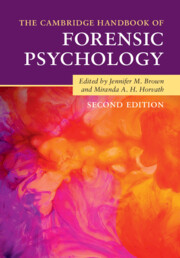Book contents
- The Cambridge Handbook of Forensic Psychology
- The Cambridge Handbook of Forensic Psychology
- Copyright page
- Dedication
- Contents
- Figures
- Tables
- Contributors
- Preface
- Forensic Psychology
- Part I Psychological Underpinnings
- 1.1 Cognitive Theories of Crime
- 1.2 Child and Adolescent Offending
- 1.3 Investigative Psychology
- 1.4 Neurological Theories
- 1.5 Personality
- 1.6 Theories of Sexual Offending
- 1.7 The Psychology of Violent Behavior
- 1.8 Investigative Decision-Making
- Part II Psychology and Criminal Behaviour
- Part III Assessment
- Part IV Interventions
- Part V Civil Proceedings
- Part VI Professional Practices
- Index
- References
1.1 - Cognitive Theories of Crime
from Part I - Psychological Underpinnings
Published online by Cambridge University Press: 02 December 2021
- The Cambridge Handbook of Forensic Psychology
- The Cambridge Handbook of Forensic Psychology
- Copyright page
- Dedication
- Contents
- Figures
- Tables
- Contributors
- Preface
- Forensic Psychology
- Part I Psychological Underpinnings
- 1.1 Cognitive Theories of Crime
- 1.2 Child and Adolescent Offending
- 1.3 Investigative Psychology
- 1.4 Neurological Theories
- 1.5 Personality
- 1.6 Theories of Sexual Offending
- 1.7 The Psychology of Violent Behavior
- 1.8 Investigative Decision-Making
- Part II Psychology and Criminal Behaviour
- Part III Assessment
- Part IV Interventions
- Part V Civil Proceedings
- Part VI Professional Practices
- Index
- References
Summary
The application of cognitive theories to criminal behaviour has moved through various stages. Sutherland’s Differential Association Theory (1930s/40s) introduced the notion of cognitions (definitions in the theory) as a factor in explaining crime. Following Skinner’s operant learning, Bandura’s social learning theory (1960s/70s) emphasised the role of cognition acquiring and maintaining behaviour, including criminal behaviour. In the 1980s social information processing articulated the sequence of encoding social cues, interpretation of cues, clarification of response goals, response access or construction, response decision and behavioural response. These cognitive processes may be affected by the individual’s emotional state, particularly anger in crimes of interpersonal violence. The 1980s also gave the view of the criminal as a rational decision-maker prepared to seize an opportunity to offend. The theories have given two contrasting approaches to crime reduction: (i) change offenders’ thinking and values; (ii) remove the opportunity for crime through situational crime prevention.
Keywords
- Type
- Chapter
- Information
- The Cambridge Handbook of Forensic Psychology , pp. 19 - 34Publisher: Cambridge University PressPrint publication year: 2021

